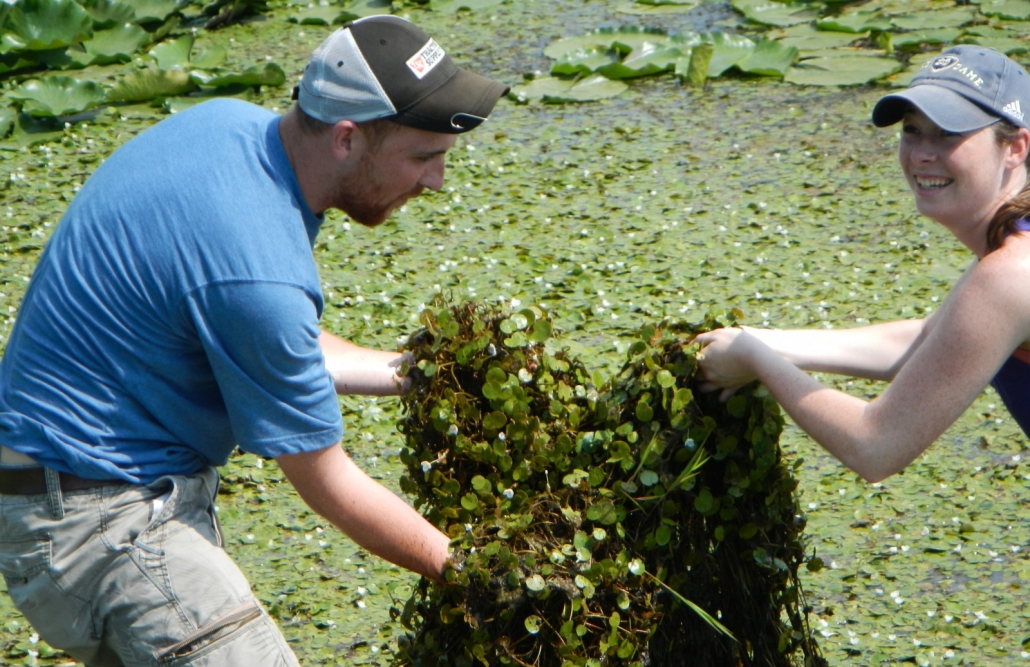Control for Frog-bit and Water Soldiers

The European frog-bit looks like a little lily pad and lives in shallow waters. Image: Shelby Bauer, Huron Pines
New strategy for limiting the spread of exotic water plants in Michigan.
By Vladislava Sukhanovskaya – August 8, 2023
Circle of Blue
In the waters where it’s a native species — Europe, Asia, and Africa – the aquatic plant known as European frog-bit is no trouble at all. Though its name summons images of slime and bumps, frog-bit is a decorative display of coin-size leaves that in shallow water look like lily pads and serve as a source of food for insects, snails, rodents, waterfowl, and fish.
In the 1930s, frog-bit was transported out of its home region to decorate ponds and aquarium tanks in the U.S. and Canada. It escaped, likely in the first half of the century, And like so many other non-native exotic species of plants and animals started to spread in streams and rivers to make its way to Michigan, the waters of the Great Lakes, and to parts of New York, Ohio, Pennsylvania, Vermont, and Washington where it has no predators.
Almost a century later, frog-bit has become a formidable nuisance, especially along parts of Lake Huron and in southeast Michigan. First, the plant forms mats in Michigan surface waters so thick that they block sunlight and diminish oxygen levels for native species, and make it impossible to swim, boat, or fish. Second, frog-bit defies effective control.
In June, the U.S. Army Corps of Engineers promoted what the agency hopes will be a new strategy for frog-bit control. It offered researchers a $200,000 grant to develop a biological control for the frog-bit and its relative – water soldier.
The urgency is evident. One major cause of frog-bit’s expanding presence, say state authorities, is that boat owners are not following the “clean, drain, dry” rule to remove remnants on their hulls. The consequence is that in Michigan, frog-bit is creeping inland. Established populations are found in Monroe, Wayne, Macomb, St. Clair, and Wayne counties. It has been documented in 12 counties in total, including Arenac, Alpena, Kent, and Chippewa.

Frog-bit distribution in the Great Lakes area – Image: Midwest Invasive Species Information Network
“You should clean your boat before you leave. Ideally, dry it off and drain any water out of it. So that you’re not moving water and mud that has seeds or turions in it,” said Tom Alwin, a senior aquatic biologist at the EGLE who works with aquatic invasive species.

What parts of your boat to check for invasive species. Image: Tip of the Mitt Watershed Council
Additionally, the frog-bit can move without human help using water currency. On top of its mobility, frog-bit is an evolutionary intelligent fighter. It is hiding among other plants such as cattails, said Noah Jansen, a restoration manager at Tip of the Mitt Watershed Council based in Petoskey, Michigan.
And if you miss one or two plants, the frog-bit will rebound and appear in the same place again, Alwin said.
That’s because frog-bit is resourceful. The plant uses two reproduction strategies to spread – seeds and turions, a bud that is capable of growing into a complete plant. Seeds and turions can’t be eradicated by herbicides. They hide on the bottom in the mud and wait till the right time to grow.

Hand removal of frog-bit. Image: Michigan DNR, Wildlife division
Hand pulling can work for adult plants. “It’s a rewarding feeling to reach into the water and pull out a big handful of it and know that you’re removing it from the ecosystem. But it’s a lot of work if you’re gonna do it all day long,” said Chris Engle, communication associate at the non-profit Huron Pines, based in Gaylord, Michigan.
With its grant for biological control, the Army Corps is embarking on a program of research, safety testing, and approval of a new frog-bit eradication strategy.
Michigan has had some success with bio-control. In 1994, the state introduced – the Galerucella beetle, which feeds on invasive purple loosestrife, a shoreline plant displacing native plants across the state.
Engle said that several hundred beetles were recently released in Mio to eradicate the loosestrife that grows on the Sable River shoreline.
“It’s always a risky proposition to introduce a new species. But at the same time, I feel that can be a really effective way to also help control an invasive species like frog-bit,” said Jansen.
Vladislava Sukhanovskaya has two degrees in journalism. She covered health and environmental topics for Capital News Service, the Great Lakes Echo, and Circle of Blue. Vladislava was an editor for the Sober One media which helps people with addictions to recover. She is also the founder and producer of a podcast about evidence-based medicine, well-being, and sex “Nauka v Ladoshke”.












Leave a Reply
Want to join the discussion?Feel free to contribute!